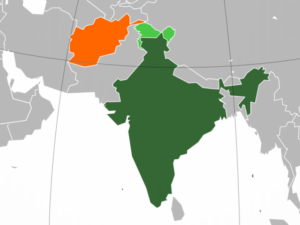Pakistan’s Defense Day: Preparing for a Two-Front Threat from India and Afghanistan

By Mirza Hammad Qamar
Pakistan’s Defense Day observed annually on September 6th, is not merely a day of remembrance but a profound affirmation of the nation’s resilience and its unwavering commitment to safeguarding sovereignty. As the nation collectively honors the valiant sacrifices of its armed forces, the significance of their enduring legacy resonates deeply through the commemorative events and military parades. These ceremonies are more than symbolic, they reflect a steadfast resolve to protect the country’s territorial integrity against persistent and evolving threats.
Since its inception, Pakistan has faced a complex and multifaceted security environment, particularly concerning its eastern and western frontiers. India, driven by historical animosity rooted in the partition of 1947 and Afghanistan, with its enduring territorial disputes and cross-border insurgencies, has posed significant challenges to Pakistan’s security apparatus. The continuous pressure from these borders, compounded by internal insurgencies such as the Kashmir dispute, Baloch separatist movements, and the activities of violent non-state actors, has necessitated a strategic and robust defense posture.
According to the Global Firepower Index 2024, Pakistan’s military is ranked as the 9th most powerful globally. This ranking is not a mere accolade but a testament to the nation’s ongoing efforts to fortify its defenses against the escalating threats from both India and Afghanistan. Pakistan’s involvement in an arms race is not a choice but a strategic necessity to counter the growing military advancements of its adversaries. The nation’s military prowess is a critical deterrent in a region marked by historical rivalries and geopolitical tensions.
India, Pakistan’s most significant and historic adversary, has been a source of persistent security concerns. The enmity between the two nations is deeply entrenched, dating back to the traumatic partition of 1947, which sowed the seeds of discord. In recent years, this hostility has been exacerbated by the rise of hyper-nationalist forces in India, particularly the Bharatiya Janata Party (BJP), whose ideological foundation is deeply influenced by the Rashtriya Swayamsevak Sangh (RSS). The RSS, an organization with a history of extremism, envisions a “Hindu Rashtra” that encompasses the entire subcontinent, including Pakistan, an aspiration that is fundamentally opposed to the existence of a sovereign and stable Pakistan.
During the 2024 election campaign, Prime Minister Narendra Modi’s incendiary rhetoric further strained relations between the two nations. His derogatory remarks about Muslims, branding them as foreign invaders and procreators, underscored the broader Hindutva agenda aimed at undermining Pakistan’s stability. The Kashmir dispute remains the most volatile flashpoint between the two nations, with India asserting its claim over Jammu and Kashmir (J&K) as an integral part of its territory, while Pakistan advocates for a peaceful plebiscite to allow the Kashmiri people to determine their future. This unresolved conflict, coupled with India’s advancements in missile technology and its growing air and naval defense capabilities, continues to pose an existential threat to Pakistan’s national security.
On Pakistan’s western border lies Afghanistan, with whom it shares the contentious Durand Line. Since 1947, Afghanistan’s refusal to recognize this border has been a persistent source of tension, fueling cross-border terrorism that has plagued Pakistan for decades. The situation has been further complicated by the U.S. withdrawal from Afghanistan and the subsequent rise of the Tehreek-e-Taliban Afghanistan (TTA), which has emboldened insurgent groups like the Tehreek-e-Taliban Pakistan (TTP). The resurgence of these groups has led to a surge in deadly attacks in Pakistan’s Khyber Pakhtunkhwa (KPK) and Baluchistan provinces, targeting both military and civilian installations.
The strategic challenges posed by these groups are not isolated but are part of a broader conspiracy involving external powers, most notably India. Indian proxies have long utilized Afghan territory to destabilize Pakistan, providing training, funding, and arms to insurgent groups to carry out terrorist activities. The two-front threat that Pakistan faces—India to the east and a volatile Afghanistan to the west—necessitates a comprehensive and multifaceted defense strategy that can address both conventional and unconventional threats.
The lessons learned from the 1965 Indo-Pak war have significantly influenced Pakistan’s military strategy over the decades. The war underscored the importance of maintaining a credible deterrent, leading Pakistan to invest heavily in its nuclear program. Today, Pakistan possesses 170 nuclear warheads, a critical component of its defense strategy that serves as a deterrent against India’s 172 nuclear warheads. This nuclear capability is not just a tool of deterrence but a guarantee of Pakistan’s sovereignty in the face of existential threats.
Pakistan’s air force has also undergone significant evolution since the 1980s, beginning with the acquisition of F-16 fighter jets from the United States. The F-16, known as the backbone of Pakistan’s air force, has provided the nation with a versatile platform for air strikes, ground support, and reconnaissance. The development of the JF-17 Thunder, a joint venture between Pakistan and China, has further enhanced the country’s aerial capabilities. The JF-17, with its Block 2 and Block 3 versions, is poised to surpass the F-16 in effectiveness, particularly in counter-insurgency operations along the Pakistan-Afghanistan border.
In addition to conventional aircraft, Pakistan has embraced modern warfare technologies, particularly unmanned aerial vehicles (UAVs) or drones. The locally produced Burraq drone, introduced in 2015, has become a key asset in counter-insurgency operations, equipped with laser-guided missiles for precision strikes. The importation of Wing Loong II drones from China has further bolstered Pakistan’s surveillance and strike capabilities, providing a strategic advantage in targeting terrorist hideouts with minimal risk to personnel. Operation Azm-e-Istehkam, Pakistan’s ongoing military campaign, has effectively utilized these drones to target insurgent camps along the western border, particularly those harboring the Fitna-al-Khwarij and other militant groups. The ongoing development and enhancement of drone technology within Pakistan underscore the nation’s commitment to maintaining a technological edge in modern warfare, ensuring that its military remains capable of responding to emerging threats.
On this Defense Day, as the nation reflects on its past sacrifices and prepares for the future, the message is unequivocal: Pakistan is ready, resilient, and resolute in the face of any adversities that may arise. The legacy of September 6th is not just a remembrance but a call to vigilance, ensuring that the nation remains prepared to defend its sovereignty and secure its place in the global order.
The views expressed in this article belong to the author only, and do not necessarily reflect the views of The Global Politico.

Mirza Hammad Qamar
The Author is the Undergraduate Student of International Relations at the University of Azad Jammu and Kashmir.
